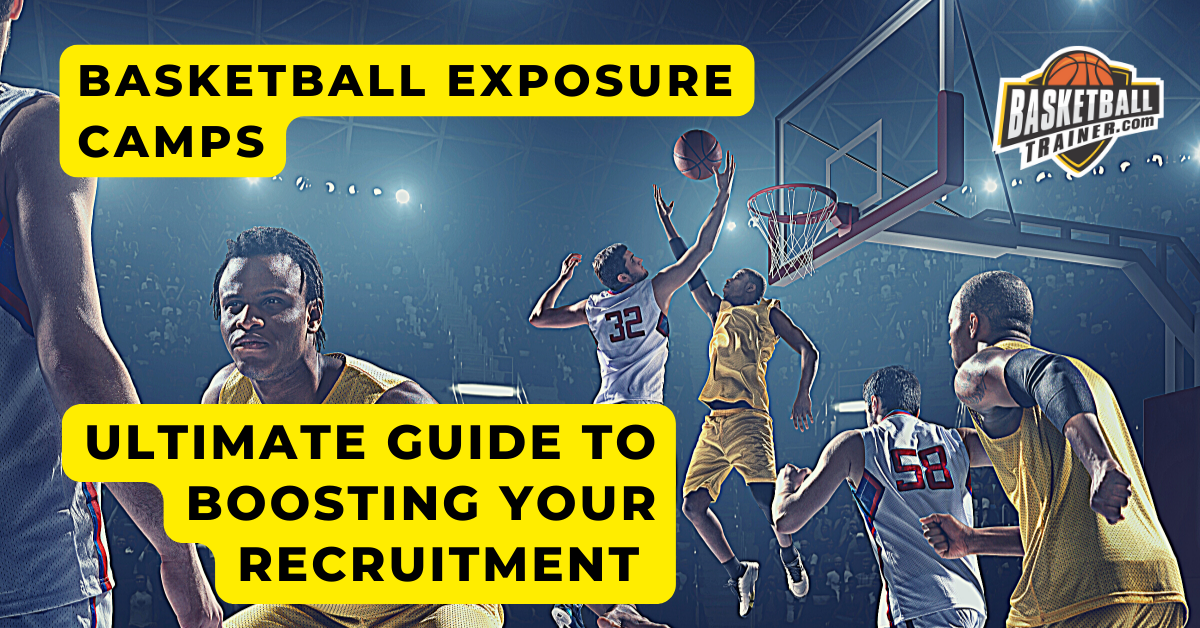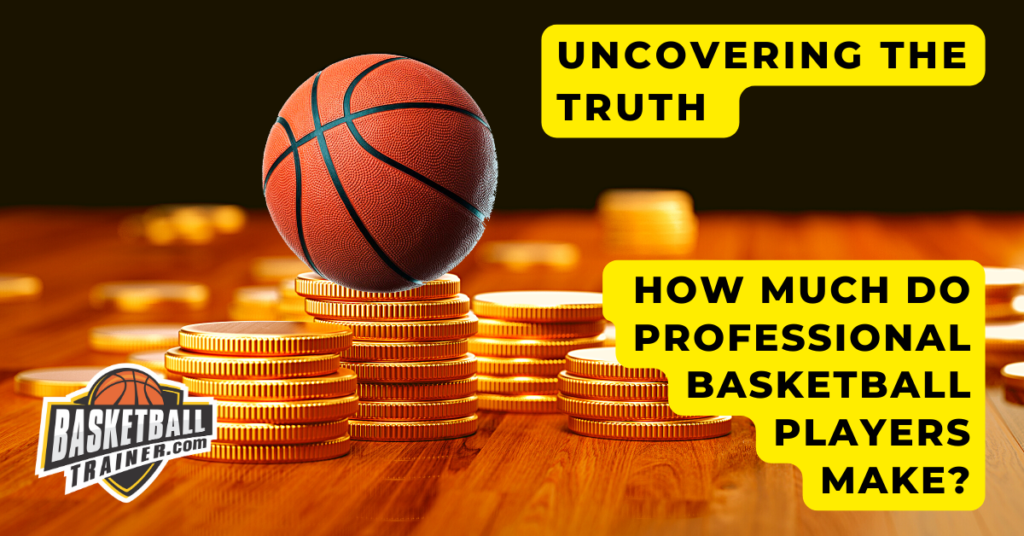
What is the ROI for investing in your child’s basketball dreams? This question often lingers in the minds of ambitious players, their families, and even coaches. To ensure a successful return on investment, it is essential to consider the various elements associated with investing in your child’s basketball dreams.
In this blog post, we will delve into why parents invest in their children’s basketball aspirations and explore various aspects related to maximizing returns on such investments. From understanding the benefits of basketball training to identifying appropriate resources and costs, setting realistic goals to tracking progress effectively – we cover it all.
Furthermore, we’ll discuss developing a support system for young athletes while utilizing technology for enhanced performance. Lastly, striking a balance between investment efforts and hard reality will be addressed alongside understanding potential risks involved with these endeavors. So let us embark on this journey together as we answer the pressing question: What is the ROI for investing in your child’s basketball dreams?
Table of Contents:
- Why parents invest in their child’s basketball dreams?
- Understand the Benefits of Investing in Basketball Training
- Identify the Right Resources & Costs
- Set Realistic Goals
- Track Progress
- Develop a Support System
- Utilize Technology
- Balancing Investment and Hard Reality
- Understand the Risks of Investment
- Asking for Help
- FAQs in Relation to What is the Roi for investing in Your Child’s Basketball Dreams
- Conclusion
Why parents invest in their child’s basketball dreams?
Parents invest in their child’s basketball dreams for a variety of reasons. Parents strive to aid their offspring in achieving success, experiencing joy and attaining the most advanced stages of basketball they can. Parents know that achieving excellence in basketball requires effort and commitment. Investing in quality training, camps, teams, and other resources is an important part of helping young players reach their goals.
When parents make the decision to invest in their child’s basketball dreams they should first consider what type of investment will benefit them most. Quality training from experienced coaches can help develop skills quickly while playing on select teams or AAU programs provide opportunities for competition against higher level opponents. Camps offer great exposure as well as an opportunity to learn new techniques from some of the best trainers around.
It is also important for parents to set realistic goals with regards to how much time and money should be invested into their child’s basketball dream. While there are no guarantees when it comes to success at any level; investing too much too soon may lead to burnout or injury if not done properly over time. Tracking progress throughout each season can help ensure that expectations are met without sacrificing safety or long-term development potential along the way.
Developing a strong support system is essential when investing in your child’s basketball dream; both inside and outside of practice sessions and games themselves. Friendships developed through teammates, coaches, instructors etc., create positive reinforcement which helps keep everyone motivated towards reaching common goals together. Utilizing technology such as video analysis software allows parents/coaches/players alike access feedback from anywhere at anytime which aids in making more informed decisions about future investments within one’s game plan.
Nurturing a child’s basketball aspirations can be an immensely rewarding experience, affording the chance to bolster their talent and bolster self-esteem. By understanding the benefits of investing in basketball training, parents can ensure that they are making an informed decision about their child’s future success.
Understand the Benefits of Investing in Basketball Training
Investing in basketball training can provide a wide range of benefits for ambitious players and their families. Physical advantages may involve enhanced dexterity, suppleness, power, swiftness and staying power. Mental benefits include increased focus, confidence and motivation as well as better decision-making skills. Social benefits include improved communication with teammates and coaches while developing leadership skills. In addition to these on court advantages, investing in basketball training can also benefit academic performance by teaching important life lessons such as time management, goal setting and problem solving.
Improved physical health is one of the most obvious returns on investment when it comes to basketball training. Aspiring athletes who engage in regular practice sessions will develop stronger muscles which will help them become more explosive on the court while increasing overall stamina so they don’t tire out during games or practices. Moreover, experienced trainers can provide athletes with the necessary stretching techniques to help reduce their risk of injury.
Mental improvements are just as beneficial as physical ones when it comes to improving your game through basketball training programs or camps led by knowledgeable instructors who have a wealth of experience playing at high levels themselves or coaching successful teams over many years . Players learn how to stay focused during long practices or intense competition which helps improve concentration both on and off the court – leading to better decision making under pressure situations like crunch time in close games where every possession counts towards victory or defeat . Confidence is also boosted from mastering new drills , executing plays correctly , understanding offensive & defensive strategies plus having positive experiences competing against other talented opponents .
Developing effective interpersonal skills is another essential factor that parents should not underestimate when investing in their child’s basketball dreams. Regular practice sessions and meaningful feedback from experienced coaches can help players hone the necessary communication, screening, passing, and defensive reading skills needed to achieve success on the court. These same qualities will serve them well in life as they progress into advanced level professionals – such as collaboration, discipline, resilience and more – all of which employers look for when hiring high-IQ individuals with 150+ intelligence quotients.
Investing in basketball instruction can be a smart move to assist your kid in achieving their ambitions and fulfilling their aspirations. To maximize your investment, identifying the right resources is essential.
Identify the Right Resources & Costs
Parents must weigh up the implications of investing in their kid’s basketball aspirations. Figuring out the expenditure and resources to put into your kid’s basketball aspirations can be intimidating. To ensure you make the right choices, it is critical to consider all necessary resources and associated costs when investing in your child’s basketball dreams.
Equipment:
Investing in quality equipment is essential for a successful basketball career. Basketballs, shoes, protective gear, apparel—all of these items add up quickly but are necessary investments that should not be overlooked. Ensure you obtain items from trustworthy sources so as to guarantee the best value for your expenditure.
Training & Coaching:
Quality coaching and training can take a player’s game to the next level. For maximum improvement, seek out coaches with a wealth of experience in guiding players from beginner to advanced levels. It may also be beneficial to look into private or group lessons if your budget allows it as this can give your child more individualized attention from a coach who understands their specific needs as a player.
Travel & Tournaments:
Travel expenses such as flights, hotels, rental cars and tournament fees can really add up quickly when playing competitively on the road or out-of-state tournaments become part of your child’s schedule. Research ahead of time so that you know what kind of travel costs are associated with each tournament before committing financially—this will help ensure that they get maximum exposure while still staying within budget constraints.
Before signing up for any commitments, it’s important to factor in the extra hours of practice, games and conditioning/strength training sessions into family life. Don’t let anyone get in over their head or be overwhelmed by the workload. Keep an eye on your budget while ensuring maximum exposure at tournaments – doing some research ahead of time will help you stay within financial constraints.
Establishing a web presence is an essential component for any basketball player hoping to achieve success in the sport. Investing in digital marketing services that specialize in creating effective personal branding strategies across multiple platforms can prove invaluable over time. With these services, athletes can maximize their exposure and stand out from the competition vying for college scholarships or professional contracts down the line. Utilizing key words and phrases, they can showcase their talents effectively and create a lasting impression on those who matter most.
As parents, we all aim to witness our offspring flourish. However, reality has its own way of dictating the outcomes regardless; so it’s important to set realistic goals with achievable timelines for everyone involved. This ensures that expectations are kept in check without being too harsh on oneself should things not go according plan – after all, failure is often a necessary part of the journey towards success. Keywords: Realistic Goals, Achievable Timelines, Expectations
Risks Of Investment:
While investing heavily into one sport might seem like best option at first glance , long term consequences must also taken into consideration . Overuse injuries caused by too much practice/competition without proper rest/recovery periods , burnout due lack variety physical activity options available , financial stress created between parents trying cover all expenses related activities etc All these risks need weighed against possible rewards before deciding whether not pursue given opportunity further .
Never hesitate to consult knowledgeable professionals such as coaches, trainers, scouts and sports psychologists for advice and assistance in tackling any issues or obstacles. Talking openly about the concerns and challenges facing them ensures everyone involved remains informed and well-equipped to tackle them head-on. This type of support network is an invaluable resource for those serious about taking their game to the next level.
Investing in the right resources and costs is key to achieving success with your child’s basketball dreams. With realistic goals, you can ensure that these investments are put to best use.
Set Realistic Goals
Setting reasonable expectations is essential when investing in your child’s basketball aspirations. Formulating an understanding of what you aspire to accomplish and the amount of effort and capital needed can assist in optimizing your resources. It’s important to consider both short-term and long-term objectives when creating a plan for success.
In terms of short-term goals, look at tangible achievements that are achievable within a reasonable timeframe such as improved skills or increased playing time on their team. As they progress, they should be able to set more ambitious targets such as earning a scholarship or making an all-star team. Longer term goals could include getting drafted into the NBA or even becoming a coach one day.
It’s also essential to factor in costs when setting realistic expectations for your child’s development. This includes fees for camps, clinics, travel teams, private training sessions and any other expenses associated with pursuing their basketball dreams. Don’t forget about additional costs like uniforms, shoes and equipment too. Having an understanding of these financial requirements ahead of time can help ensure that you have enough funds available when needed without having to scramble last minute trying to find extra cash flow sources which may not always be available.
It is essential to emphasize the development of life skills while engaging in sports activities, as this will be advantageous for your child regardless of whether they reach their ultimate objective or not. You should strive to instill character-building traits such as leadership qualities, team spirit, perseverance and commitment into them; these are invaluable assets that will serve them well beyond the court. To facilitate this process, provide guidance whenever possible – through practice drills or simply by being an attentive listener during conversations about their experiences throughout the journey.
Finally, don’t forget about the health and wellness benefits either; physical fitness plays an integral role in any athlete’s performance, so be sure to maintain proper nutrition habits as well as regular exercise routines outside of practice times. This can help improve overall conditioning levels significantly over time, resulting in better game performances that will eventually lead towards reaching those desired outcomes sooner rather than later.
Setting realistic goals is key to making the most of your investment in basketball training and player development. Progress monitoring assists in evaluating the extent of improvement, thereby permitting well-thought out decisions concerning future objectives.
Track Progress
Monitoring your child’s progress over time is a critical component of ensuring they are making steady improvements in their basketball game. Assessing one’s own performance, in conjunction with assessments from coaches and instructors, can help pinpoint regions that need extra attention. You should also monitor and record activity – how often they practice or play games, the intensity level of those practices and games, etc.
Intentionality is key when it comes to tracking progress. It’s not enough for your child to simply show up; be sure that each session has purpose behind it – whether that means focusing on specific skills or aiming for a certain number of shots made from different distances. When small wins happen – even if it’s just one shot made out of ten attempts during practice – recognize them. This will encourage your child to keep going when things get tough.
Journaling and spreadsheets can be great tools for tracking progress over time. Have your player write down what they did each day in terms of training or playing games so you have an ongoing record showing the journey towards improvement (and setbacks too). Spreadsheets allow you to easily compare data points like shooting percentage from different distances at various times throughout the season so you can see if there are any patterns developing or if something isn’t working well enough and needs adjustment.
Measuring advancement is a key piece of any b-ball preparing and competitor improvement program, as it permits players to watch their development after some time. Developing a support system around the player can further enhance this process by providing additional guidance and motivation for success.
Develop a Support System
Building a strong support system around your child is essential for their basketball journey. It’s important to understand the need for unconditional love, encouragement, and accountability when it comes to helping them achieve their goals. As parents of ambitious players, you should look to provide guidance and assistance throughout their training process.
Identify relatives who can provide transportation and nourishment, so your athlete has more time to concentrate on training and improvement. Additionally, friends can offer an emotional connection that provides comfort during difficult times. Mentors are also key in providing advice from someone outside the family dynamic which can be invaluable when working towards long-term success in basketball training and player development.
Second, set boundaries between yourself and your child so they understand expectations while still feeling supported by those closest to them. A balance between freedom and structure helps keep everyone accountable while allowing space for growth within the sport of basketball. This means encouraging good decision making skills but not overstepping boundaries when it comes to feedback or criticism during games or practices.
Utilizing technology to stay organized is key in basketball training and player development. Apps designed specifically for tracking progress can help with skill work sessions, physical workouts, film review, competition analysis and more. Locally available resources such as teams, camps or clinics should also be taken advantage of in order to learn fundamentals like dribbling drills; strength & conditioning programs; nutrition plans; shooting techniques; footwork exercises; mental toughness tactics etc By leveraging the right tools and getting creative with your approach you will have a leg up on the competition.
Fourthly set realistic goals based on age group level whether recreational league/middle school/high school/college/professional levels . Track this progress closely with measurable results such as points per game / rebounds per game / assists per game / turnovers per game / minutes played per game etc Knowing how far along they are compared to other players at similar stages gives context into what type of improvement needs to happen next . Having milestones allows everyone involved a sense of accomplishment which boosts morale along the way .
Parents should keep potential risks in mind when investing heavily into one activity, as no guarantees can be made. It’s important to have an exit strategy ready just in case things don’t go according plan; even if parents invest a significant amount of resources hoping for future returns, college scholarships are not guaranteed and professional leagues require lots of talent along with luck. One must also consider playing overseas once college ball has ended – considering these factors beforehand helps prevent any unpleasant surprises down the road after investments have been made.
If ever overwhelmed, seeking help from professionals who specialize in this field is recommended. This could include talking through issues related to performance anxiety, recruiting processes, financial planning advice, and sports psychology consultations. The right connections make all the difference in terms of achieving desired outcomes both short-term and long-term ones.
Having a strong support system is key to helping your child reach their basketball dreams. Utilizing the latest technology can help you maximize the return on investment for these efforts.
Utilize Technology
Advances in technology have enabled basketball players to expand their training and skill-building capabilities. Parents can utilize tech to assist their offspring in achieving unprecedented success on the court.
One of the most important aspects of utilizing technology is tracking performance metrics. Apps such as Coach’s Eye or HomeCourt allow users to track shooting percentages, passing accuracy, defensive plays, dribbling techniques and more. We use a combination of Dr. Dish Shooting machine and their app, the Basketball HQ.com app, and a lot of video work as well. We often track results on a Google spreadsheet, but also on our whiteboards. This data provides valuable insight into how well your child is performing on the court and helps identify areas for improvement. It also identifies plateaus, successes and failures in training.
In addition to tracking performance metrics, many apps offer personalized feedback tailored specifically for each player’s skill level. For example, an app like Hoop Tracker uses AI-driven video analysis to provide detailed insights about every aspect of a player’s game including shooting form, footwork drills and ball handling technique. By taking advantage of this type of personalized feedback from technology experts, parents can ensure that their children are receiving quality instruction no matter where they are training.
Another great way to utilize technology is by finding virtual camps or clinics that allow players to get top-notch coaching without having to leave home. Many coaches now offer remote instruction via Zoom or Skype which allows them to work with athletes from all over the world regardless of location or budget constraints. These virtual sessions also provide an opportunity for athletes who may not have access to traditional basketball programs in their area.
Finally, there are countless resources available online such as YouTube tutorials that provide free advice on everything from offensive moves and defensive strategies to proper nutrition habits for athletes looking take their game up a notch without breaking the bank. Keep in mind, Youtube does indeed have some gold, but sifting thru the garbage to get to the gold requires a level of expertise in it’s own right. It’s important that these resources be used responsibly so as not overload young minds with too much information at once – it’s best practice focus on one specific skill at a time when using these types videos instead trying tackle everything all once.
Overall, investing in technologies can be very beneficial if done correctly but it should always go hand-in-hand with hard work both physically and mentally – because ultimately you still need to put in long hours perfecting your craft before any tech will make a real difference. Gaining insight from those with experience in the field is essential for achieving success, as it allows one to leverage their wisdom and avoid missteps.
Utilizing technology to optimize training and development can be a powerful tool for ambitious basketball players, but it’s important to remember that there is also a hard reality when investing in your child’s basketball dreams. As such, the next step is understanding how best to balance investment with realistic expectations of success.
Balancing Investment and Hard Reality
When it comes to investing in your child’s basketball dreams, the hard reality is that there are financial costs associated with getting them on the court. Whether you’re looking into team fees, private coaching, or specialized camps and clinics, all of these resources come at a cost. Consequently, it is essential to budget prudently in order to maximize the return on your investment without overburdening yourself financially.
One example of this type of decision-making is when parents decide whether to invest in their child’s sport rather than save for retirement. This can be a difficult choice as both options have long-term implications but require different kinds of investments. Parents should weigh up the pros and cons before making any decisions about how they want to allocate funds between basketball training and other family priorities such as retirement savings.
It’s also important for parents to set realistic goals for their child’s basketball dreams so they know what kind of return they can expect from their investment. Setting achievable objectives will help keep expectations grounded and avoid disappointment down the line if things don’t go according to plan. Additionally, keeping an eye on progress allows families to make sure they’re not wasting money by going overboard with spending on unnecessary activities or equipment that won’t bring results in terms of skill development or performance improvement.
Education is another factor that needs consideration when it comes to balancing investment with hard reality – particularly when children get older and start thinking about college scholarships or even professional careers in basketball later down the line. Parents should make sure their kids understand that while playing sports provides many benefits outside just physical activity – such as discipline, teamwork skills etc – academic achievement still needs attention if they want those doors open after high school graduation.
Utilizing technology can create a more efficient path to success, allowing players to focus on specific weaknesses rather than squandering time attempting to remedy everything simultaneously. Video from a phone and one-on-one sessions provide detailed analysis which helps identify areas needing work quickly and effectively.
Finally, it is essential for ambitious athletes (and their families) to build support systems comprised of friends and family who understand what it takes to succeed against odds stacked against them. These people should share the same values and commitment levels necessary to reach the highest heights possible within the sport itself while understanding the importance of living a balanced life away from courts, fields, or arenas as well.
Investing in your child’s basketball dreams is a balancing act between the hopes of success and hard reality. Realizing the potential dangers of investing in a child’s basketball aspirations is an absolute must for any parent desiring to make a wise choice regarding their offspring’s future.
Understand the Risks of Investment
Basketball can teach kids the value of collaboration, effort, and perseverance. However, it is important for parents to understand that investing in their child’s basketball dreams can come with risks. It’s not a zero-sum game; there are no guarantees of success or failure.
The potential for burnout is one risk associated with investing in basketball training. Players need breaks from the court as well as time away from competition and practice drills. Parents should be aware of signs such as fatigue, lack of motivation, irritability or apathy towards playing which may indicate burnout and take appropriate steps to address it before it becomes an issue.
Injury is another risk that must be considered when investing in basketball training. While injuries cannot always be avoided during physical activity, proper warm up routines and stretching exercises can help reduce the chances of injury occurring on the court. Additionally, having access to quality medical care if needed will ensure that any injuries sustained are treated properly so they do not become long term issues down the road.
It’s also important to consider what happens if goals are not achieved despite all efforts put into them? This could mean anything from failing to make a team or winning tournaments all the way through college recruitment opportunities being missed out on due to various factors outside anyone’s control such as talent level or age restrictions etc. Parents should discuss this possibility openly with their children so everyone involved understands what might happen even after putting in considerable effort over many years into achieving certain objectives related to playing basketball at higher levels than just recreational play .
Parents looking to maximize their return on investment while minimizing risks should be sure to devise a thoughtful plan for investing available resources (time and money) into helping their child achieve desired goals. This can include keeping tabs on progress through regular assessments, setting realistic objectives, finding the right resources at an appropriate cost, building up a support network around the player, and taking advantage of technology tools like online coaching apps. With these pieces in place they’ll have all they need to navigate the waters successfully without getting overwhelmed by it all.
Finally, it is worth noting that asking for help when needed from coaches, trainers or other experienced individuals who have gone through similar situations before can be beneficial. These people often have valuable insights based on their own experiences which can prove invaluable.
Investing in your child’s basketball dreams can be a risky endeavor, but with the right information and support it is possible to minimize those risks. Seeking counsel from experienced basketball experts can be a great way to ensure your investment in your child’s hoop aspirations is maximized.
Asking for Help
To ease the financial burden, parents should consider asking for help from a variety of sources. Scholarships are often available through clubs or leagues that offer camps and other activities. Additionally, some companies may be open to offering discounts or bartering services in exchange for assistance with promotional activities.
Facebook groups can also be helpful resources when looking for assistance with funding basketball dreams. These communities often have members who are eager to support young athletes by providing advice on how to find sponsorships. Moreover, these online communities offer a chance to meet others who share the same dedication needed when striving to achieve one’s basketball ambitions.
Parents should also consider bartering as another way to reduce costs associated with player development and training opportunities. This could include exchanging services such as tutoring or house cleaning in exchange for free lessons or discounted rates on camps and clinics offered by local coaches or trainers. While this method may not always work out, it’s worth exploring if finances are tight but you still want your child involved in quality basketball programs without breaking the bank account.
Don’t hesitate to inquire with those close to you about providing financial assistance for your child’s aspirations of becoming an elite athlete – even small amounts can go a long way in the grand scheme. It is important that parents remain realistic about what they can afford while continuing to set achievable goals; however, there is no harm in seeking additional support from those around you if needed – after all, everyone loves seeing someone achieve their dreams.
FAQs in Relation to What is the ROI for investing in Your Child’s Basketball Dreams
Why you should invest in your child’s future?
Deciding to invest in your child’s future is a crucial choice with lasting implications, and the right resources can help them reach their maximum potential. With the right resources, such as expert trainers, teams, camps and training products and apps, your child can reach their full potential. By providing them with the necessary guidance to develop their skills and knowledge of basketball they will gain confidence which could lead to higher performance levels both on and off the court. Investing in a comprehensive program tailored specifically for your child’s needs will give them access to experienced professionals who understand what it takes to become successful in this sport.
Why is investing in children important?
Investing in children is essential for the future of society. Investing in kids is key for a better tomorrow; giving them access to quality instruction, healthcare, sustenance and other essential components needed for their growth will make sure they have the capabilities required to flourish as adults. Additionally, investing in children also helps create a more equitable society by reducing disparities between those who have access to these resources and those who do not. Ultimately, investing in our youth today ensures that we will have a brighter tomorrow.
What is the return on every dollar spent on education?
The return on investment in education is immense. Education provides a foundation for success, with increased earning potential and greater career opportunities. It also offers personal growth through knowledge acquisition, problem-solving skills, and the ability to think critically. With an educated workforce, businesses can increase their productivity while individuals gain confidence and satisfaction from being able to achieve more than they thought possible. Education is a worthwhile investment with lasting benefits.
Conclusion
Before taking the plunge and investing in your child’s basketball aspirations, it is wise to weigh up both the potential risks and rewards. It is essential for parents to understand the benefits of investing in training and resources, set realistic goals, track progress and develop a support system. Technology can also help make this process easier by providing access to helpful apps or tracking tools that enable you to better measure ROI (return on investment). Ultimately, balancing investments with hard reality will ensure success when pursuing any dream – including one related to basketball.
Invest in your child’s basketball dreams with BasketballTrainer.com and unlock the potential of their success through expert training, teams, camps, products and knowledge. Let us help you maximize the ROI for your investment today!





 “How to improve basketball handles?” is one of the top questions I get asked as a professional basketball trainer and former NYC point guard. As a basketball player, honing your ball handling skills is essential for success on the court.
“How to improve basketball handles?” is one of the top questions I get asked as a professional basketball trainer and former NYC point guard. As a basketball player, honing your ball handling skills is essential for success on the court.


 Finally, don’t forget about music – choose songs that will keep energy levels high throughout the night while also providing appropriate background noise for conversations taking place among attendees (think upbeat hip hop tunes). Consider ESPN Jock Jams and old basketball favorites. And lastly, make sure there’s enough room onsite for dancing if desired by anyone present at your event; because after all, what would a basketball themed party be without some sort of dance off?
Finally, don’t forget about music – choose songs that will keep energy levels high throughout the night while also providing appropriate background noise for conversations taking place among attendees (think upbeat hip hop tunes). Consider ESPN Jock Jams and old basketball favorites. And lastly, make sure there’s enough room onsite for dancing if desired by anyone present at your event; because after all, what would a basketball themed party be without some sort of dance off?



 Choosing the right wall decor for a basketball-themed room or space is an important part of creating a cohesive look. Whether you’re creating a bedroom, playroom, or man cave dedicated to the sport, there are plenty of options to choose from. Here are some tips and ideas for finding the perfect basketball wall decor.
Choosing the right wall decor for a basketball-themed room or space is an important part of creating a cohesive look. Whether you’re creating a bedroom, playroom, or man cave dedicated to the sport, there are plenty of options to choose from. Here are some tips and ideas for finding the perfect basketball wall decor.








 Professional basketball players make some of the highest salaries in all of sports. The NBA is renowned for its star athletes, who are handsomely rewarded due to the league’s high salary cap and lucrative contracts. Pay for NBA players can be drastically different, contingent on multiple aspects such as the team’s salary limit, individual productivity and contract duration.
Professional basketball players make some of the highest salaries in all of sports. The NBA is renowned for its star athletes, who are handsomely rewarded due to the league’s high salary cap and lucrative contracts. Pay for NBA players can be drastically different, contingent on multiple aspects such as the team’s salary limit, individual productivity and contract duration. The NBA has implemented a salary cap system to ensure parity among its teams by limiting their spending on player salaries each season, based on the total income of all 30 franchises. The NBA salary cap is the maximum amount of money each team can spend on players’ salaries during a season. It is calculated based on the total income of all 30 teams combined and is adjusted annually.
The NBA has implemented a salary cap system to ensure parity among its teams by limiting their spending on player salaries each season, based on the total income of all 30 franchises. The NBA salary cap is the maximum amount of money each team can spend on players’ salaries during a season. It is calculated based on the total income of all 30 teams combined and is adjusted annually.

 By journaling, basketball players can unlock their potential to reach a higher level of performance. By reflecting on games and practices, players can gain valuable insight into their performance and develop a plan for improvement.
By journaling, basketball players can unlock their potential to reach a higher level of performance. By reflecting on games and practices, players can gain valuable insight into their performance and develop a plan for improvement. Journaling can be an effective way for basketball players to advance their capabilities and realize their ambitions. By regularly reflecting on their games and practices, players can create an actionable plan that will help them make progress faster.
Journaling can be an effective way for basketball players to advance their capabilities and realize their ambitions. By regularly reflecting on their games and practices, players can create an actionable plan that will help them make progress faster.




















